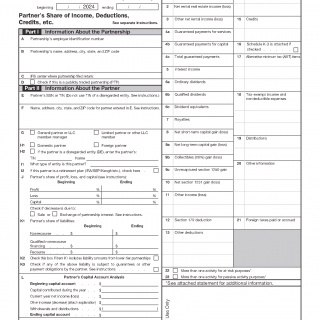IRS Form 1065. Schedule K-1. Partner’s Share of Income, Deductions, Credits, etc.
Schedule K-1 (Form 1065) for 2024 is an essential IRS document that details a partner’s share of income, deductions, credits, and other financial information from a partnership. This form is required for each partner to accurately report their portion of the partnership’s tax items on their individual or entity tax returns.
Purpose of Schedule K-1 (Form 1065)
The main purpose of Schedule K-1 is to provide partners with the necessary tax information about their share of a partnership’s financial activity. It ensures proper reporting of income, losses, and other items to the IRS and helps partners comply with federal tax laws.
Who Must File and Who Receives the Form
Partnerships must prepare a Schedule K-1 for every partner, including general partners, limited partners, and LLC members treated as partnerships. Partners include individuals, corporations, trusts, and retirement accounts that hold an interest in the partnership.
Legal and Regulatory Context
Schedule K-1 is governed by the Internal Revenue Code, primarily Sections 701 through 704, which outline partnership taxation and reporting requirements. Compliance is mandatory; failure to provide accurate K-1s can result in penalties for the partnership and inaccurate tax reporting for partners.
Part I — Information About the Partnership
- Employer Identification Number (EIN): Unique IRS number identifying the partnership.
- Partnership Name and Address: Official name and physical location of the partnership.
- IRS Filing Center: Indicates where the partnership’s Form 1065 was filed.
- Publicly Traded Partnership Check: Marks if the partnership is publicly traded.
Common mistakes include providing outdated addresses or incorrect EINs.
Part II — Information About the Partner
- Partner’s SSN or TIN: Must be correct; do not use TINs of disregarded entities.
- Partner Name and Address: Ensure this matches IRS records.
- Partner Type: Identifies general, limited, or LLC member-manager status.
- Domestic or Foreign Partner: Clarifies tax reporting obligations.
- Retirement Plan Indicator: Flags IRA, SEP, Keogh, or other plans.
Errors in partner identification can trigger IRS notices or processing delays.
Part II — Partner’s Share of Profit, Loss, and Capital
This section shows beginning and ending percentages of profit, loss, and capital contributions. Partners should review these numbers to verify they match partnership agreements.
- Check for decreases due to sale or exchange of partnership interests.
Part II — Partner’s Share of Liabilities
Liabilities are broken into nonrecourse, qualified nonrecourse financing, and recourse categories. Partners should note any liabilities subject to guarantees, which affect individual risk exposure.
Part II — Capital Account Analysis
- Beginning Capital Account
- Capital Contributed During the Year
- Current Year Net Income (Loss)
- Other Increases/Decreases
- Withdrawals and Distributions
- Ending Capital Account
Partners must attach explanations for adjustments or property contributions with built-in gains or losses.
Part III — Partner’s Share of Current Year Items
- Ordinary Business Income (Loss)
- Net Rental Real Estate Income (Loss)
- Other Net Rental Income (Loss)
- Guaranteed Payments for Services and Capital
- Interest, Dividends, Royalties
- Capital Gains/Losses (Short-Term and Long-Term)
- Section 179 Deduction, Other Deductions, Self-Employment Earnings
- Credits, AMT Items, Tax-Exempt Income, Distributions
- Foreign Taxes Paid or Accrued
- Other Information as Required
Carefully review each item; misreporting can affect partner tax returns and may trigger IRS adjustments.
Practical Tips for Filling Out Schedule K-1
- Verify all partner identification numbers and addresses match IRS records.
- Double-check percentages of profit, loss, and capital.
- Attach supporting statements for property contributions with built-in gains/losses.
- Review liabilities carefully, especially recourse obligations.
- Ensure all income, deductions, and credits are accurately reported to prevent IRS corrections.
Real-Life Examples
- A limited partner in a real estate LLC receives a K-1 to report rental income and their share of losses on their personal tax return.
- An LLC member-manager contributing additional capital mid-year uses Schedule K-1 to track updated ownership percentages and capital accounts.
- A foreign partner uses K-1 to report U.S.-source partnership income for proper international tax compliance.
FAQ — Frequently Asked Questions
When do I need Schedule K-1?
Every partner must receive a K-1 for the partnership’s tax year to report income or loss correctly.
Who prepares the form?
The partnership or LLC is responsible for preparing and sending K-1s to all partners.
What documents should be attached?
Attach statements for property contributions, adjustments, or other special allocations as indicated in instructions.
Can I file electronically?
Yes, K-1 information can be included in electronic Form 1065 filings.
What happens if I receive incorrect information?
Contact the partnership immediately to issue a corrected (amended) K-1.
Are foreign partners treated differently?
Yes, they must follow IRS rules for U.S.-source partnership income reporting.
Micro-FAQ — Quick Answers
- Purpose: Report partner’s share of income, deductions, and credits.
- Who files: Partnership or LLC sends to partners.
- Deadline: Typically by the due date of Form 1065 (March 15 for calendar-year partnerships).
- Attachments: Supporting statements for property contributions or allocations.
- Submitted to: Each partner and IRS.
Related Forms
- Form 1065 — U.S. Return of Partnership Income
- Schedule K-3 — Partner’s Share of International Activities
- Form 1040 — Individual Income Tax Return
- Form 1120 — U.S. Corporation Income Tax Return
Form Details
Name: Schedule K-1 (Form 1065)
Number: 1065
Region: United States
Revision Date: 2024

